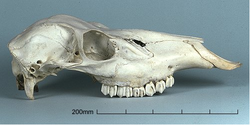
I am going with my girlfriend and we are really excited about the trip. We are working on a collaboration between UC Santa Barbara and the Universities of Cambridge and Edinburgh. The skulls that we will be measuring are from a very well studied population of deer. Researchers have been studying red deer on rum for decades (Red Deer Project) and some of the seminal behavioural ecology papers have been produced from research carried out on these animals. We're helping out in a project investigating cranial capacity and life-history traits, which will hopefully produce some interesting results.
While we are there we get to experience an amazing Island. I am hoping to take some nice photos of the scenery and wildlife. But to be honest I am mainly excited about not having to sit behind a computer for the next month and a half. If I get the chance to put some pictures up then I'll try and put them on my blog or on flckr.
Here are some links to sites about Rum:
http://en.wikipedia.org/wiki/R%C3%B9m
http://www.isleofrum.com/


 RSS Feed
RSS Feed
